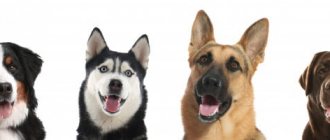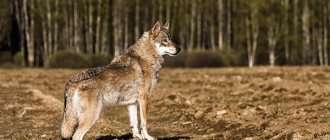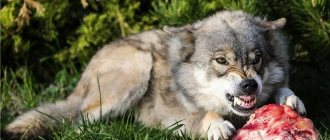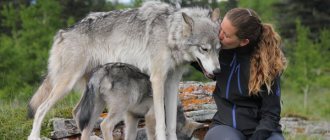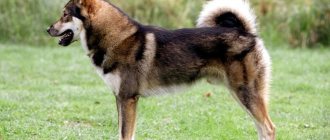Wolf dogs benefit from exposure to many different people, places and situations as puppies so they don't become afraid, which can lead to biting.
However, training in general presents significant challenges: wolf dogs are not as eager to please their handler as a domestic dog, which is bred and raised to do so. Additionally, wolfdogs do not make good pets.
Not only can male and female wolfdogs mark furniture and otherwise cause physical problems in the home, but they also pose a danger to children and other pets.
Hormonal changes during puberty can add another layer to a wolfdog's unpredictability, although neutering may tame some of its wild instincts.
In addition, wolfdogs require an enormous amount of exercise—three to four hours a day—and will have health problems if kept indoors.
With this in mind, wolfdogs need to:
- an enclosed space in which to wander; wolfdogs work best in pairs or groups;
- heavy chain-link fence, at least 2.5 meters high; fences should be angled inward to make it even more difficult for the animal to escape;
- buried concrete barriers with reinforced mesh placed along the base of the fence to prevent wolf dogs from escaping;
- lockable double gates at least 2 meters high;
- adequate soil drainage so that wolfdogs can find dry areas in wet weather;
- a doghouse with enough space for the wolfdog to comfortably shelter from the elements (ideally with a shelf so the animal can sit up high);
- vegetation and ground cover to provide shade, grass for food and cover (make sure trees are not close enough to the fence for the animal to climb and escape)
History of the breed
A wolf dog is a hybrid of a wolf and a dog. The name comes from two words: “wolf” and “dog”. The remains of similar animals have been found in Europe; such fossil finds date back to the era of mammoths and cavemen.
At first, crossing between two species of animals took place without human intervention. Then people attempted planned crossing, wanting to get tame wolf-dogs.
In Great Britain in the eighteenth century, dog handlers managed to obtain offspring from a male wolf and a female shepherd dog. The puppies were nicknamed Pomeranian dogs. But the experiment was not a success; the mestizos grew up wild and were difficult to educate. It was not possible to completely tame them. As a result, such experiments were stopped.
The British were the first, but not the last, who tried to get tame wolfdogs. Crossing of wolves with shepherd dogs, huskies, huskies and poodles was carried out in the Czech Republic, Germany, and Norway. The result was far from what was desired; it was not possible to obtain a completely domesticated hybrid.
In different countries there are dog breeds bred on the basis of the wolf dog:
• China – Kunming Shepherd. • Netherlands – Saarloos wolfdog. • Czechoslovakia – Czechoslovakian Wolfdog.
In Russia, for many years, work has been carried out on the creation of a service wolfdog. The desired result was achieved not so long ago, namely at the beginning of the twenty-first century.
In 2003, scientist Kasimov successfully mated a purebred she-wolf, Naida, purchased from hunters, with a male German shepherd. The result exceeded expectations. The puppies inherited the mother's exterior and the father's character and service abilities.
Further selection work was carried out at the Perm Institute of Internal Troops. Purebred German Shepherds and purebred wolves were used in the process. Dog handlers developed the abilities in wolfops that would be needed for service in the army, on the border, and when searching for violators.
The Russian wolfdog is an animal controlled by a person, provided that this person is a professional and an expert in this new, one might say, complex breed.
Mating
Service Wolfdogs are usually not bred with each other, because the number of wolf genes decreases. And this leads to the fact that such qualities as, for example, sense of smell, gradually become worse, and such dogs are no longer suitable for service.
- At home, pets can be bred, just like ordinary dogs . But this can be quite difficult, because Wolfdogs are just starting to gain popularity, and finding a partner is not so easy.
- It is better to breed after the third heat . That is, approximately eighteen months.
- First you need to prepare properly . To do this, it is necessary to provide the dogs with enough water. The floor in the room is covered with carpet. This is done to prevent the animals' paws from slipping. Just in case, dogs are muzzled.
- Help may be needed at the initial stage of mating , when the male leans his body onto the female. Further, when it comes to the “castle”, it is better not to disturb the pets.
Read a detailed article on the topic: “Everything you need to know about breeding dogs: appropriate age, what to do if it doesn’t work out, rules and tips.”
Breed standard
There is a misconception that Malamutes are wolfdogs. In fact, the Malamute is no more related by blood to wolves than, for example, a pug. It’s just that the northern breed is similar in appearance to the wolf-dog.
The International Canine Federation has never recognized the Russian wolf-dog as an independent breed with an officially established standard. Therefore, there are no strict requirements for the exterior of the wolfcop. But there is a description of the appearance of these animals.
Most representatives of the breed are practically indistinguishable from wolves. An ignorant person can easily confuse a domestic wolfdog with a wild wolf.
Adults are large, lean, with strong bones and well-developed muscles. Height at the withers is about 60-70 cm , weight 30-50 kg. These are average figures; there are Russian wolf-dogs weighing 65-70 kg.
A large head rests on a medium-length, strong, dry neck. The ears are medium in size, erect, set high. The forehead is wide. Almond-shaped eyes of medium size. Color brown or amber. The look is stern, wary, studying.
The muzzle is long, “wolf-like”. The nose is large. The fangs are large, the teeth are sharp. The jaws are powerful and symmetrical in relation to each other. Scissor or pincer bite. The Wolfops bite is the ultimate weapon.
The body is lean, the back is straight, the croup is powerful. The chest is muscular and does not reach the elbows.
The limbs are long, straight, strong, noticeably close to each other.
The tail is set high, thick and long.
The coat is of medium length, close-lying. Hard to the touch. The guard hair is smooth and straight. There is a thick, dense undercoat.
Coat color largely depends on which dog the cross was made with. Most wolfdogs are black, gray, and off-white. A combination of several colors is possible.
Distinctive features
The wolfdog differs from both the dog and the wolf . Representatives of this breed are very similar in appearance to a wolf, but in their obedience and devotion to humans they are similar to domestic dogs. Wolfdogs are smaller in size than a wolf, but larger than a dog. This breed combines all the traits of its parents equally:
- Size and weight: male – 60 cm and 50 kg; female – 55 cm and 40 kg.
- Head: elongated, proportional to the body.
- Eyes: almond-shaped, amber or light brown in color.
- Ears: triangular, protruding, medium size.
- Nose: developed, wide nostrils, color only black.
- Neck: dry, at an angle of 40˚.
- Paws: The front legs are straight and narrowly set, the paws are turned out, high, muscular.
- Torso: fit, muscular.
- Tail: set high, reaching to the metatarsus, thick.
- Coat: thick, with undercoat.
- Color: wolf (from light gray to dark, brown and black).
Maintenance and care
The wolfdog is not suitable for keeping in an apartment. It is absolutely forbidden to lock such an animal in a cramped enclosed space. Representatives of the breed love freedom and space. Wolfops are also not afraid of loneliness; they are not demanding of their owner’s attention. This does not mean that communicating with a wolf-dog hybrid is rare. In order for a trusting relationship to be established between a person and a half-wolf, it is recommended to contact the pet as often as possible.
A wolf-dog needs to be kept in an enclosure; if it is chained, its character will deteriorate. The enclosure should be spacious. The animal also needs comfort, despite its wild heritage. Therefore, install an insulated booth and some obstacles in the enclosure; the space should not be empty. Buy some toys.
Do not build the enclosure in a draft; provide shelter from the sun. If you let your pet run freely around the yard, make sure that the fence is high enough. To avoid undermining, the fence is buried 40-50 cm into the ground. Remember that the wolfdog loves to chew everything, dig holes in the ground, and he is also capable of jumping high.
Daily physical activity and training are vital for the wolf-dog. Regular walks at a leisurely pace will not be enough for such an active, energetic animal. Walk your dog at least twice every day, each walk lasting at least an hour.
It is important to consider that wolf-dogs are most active at night. Therefore, leave longer walks or workouts for the evening.
Caring for a mixed breed is the same as for ordinary dogs. The procedures to maintain the appearance and health of the wolf-dog in excellent condition are quite simple. The main thing is to do them regularly, correctly and on time. The list of necessary procedures is outlined below:
- We comb the fur once every 6-8 days. During seasonal shedding, brushing is required daily.
- We bathe 2 times a year.
- To clean your teeth, it is recommended to use special bones, which are sold in a veterinary pharmacy. The wolfdog has an extremely negative attitude towards brushing with toothpaste.
- We examine the eyes daily, removing morning discharge if necessary.
- We clean our ears 1-2 times a week. If discharge regularly accumulates or inflammation is detected, immediately contact a veterinary clinic. This may be a signal of an infectious disease.
- The claws wear down on the road surface, so no trimming is required.
We train mixed-breeds to all of the above procedures from puppyhood. Otherwise, it will be quite difficult to control a wayward pet.
For a wolf-dog hybrid, a protein diet and homemade food are recommended. Two meals a day are required. You cannot feed a wolfcop more often; if overfed, representatives of the breed quickly develop obesity with subsequent health problems.
There is always a fairly large container with cool, fresh water in the enclosure.
Features of character and behavior
Initially, Volkosobs were bred specifically for official purposes. Now they can be found as pets.
- The character of representatives of this breed directly depends on the content of wolf genes in their DNA . Even fourth-generation dogs can be too aggressive and distrustful of people. Therefore, Wolfdog should be trained only by professional dog handlers.
- Wolf dogs are distinguished by their extreme intelligence . Because of the German Shepherd's genes, they learn commands quickly and are not difficult to train.
- Unlike their domestic parents, Wolfdogs, thanks to their sense of smell, complete search tasks 10 times faster. It takes a shepherd 6 minutes, a wolf-dog less than a minute. The jaws of this unusual breed are many times stronger. If he grabs your hand, it is almost impossible to unhook him. It will only be released on the owner's command.
- Wolves are social animals. They constantly need a pack and a leader. So are Wolfdogs . They always need a leader, and if the owner cannot show that he is in charge, the pet can begin to dominate. This will result in a complete loss of control over the dog. It is precisely because of the love for the pack, transmitted from the wolf, that Wolfdogs like to live in large families.
- Wolf dogs are quite friendly . They can easily make friends with anyone. This is good when an adult dog is adopted. But you should not teach them to have good relationships with strangers, because this breed is intended for protection.
Advantages
The wolf-dog has many advantages:
- Developed intelligence;
- Excellent memory. remember commands well;
- Excellent security qualities;
- Judge hereditary diseases;
- It will not just howl or bark, it is quiet;
- Playfulness;
- Sociability;
- Acute sense of smell and hearing;
- Longevity. Life expectancy (up to 20-30 years);
- Easy adaptation to changing living conditions;
- Easy grooming;
- Friendliness;
- Good cold tolerance.
Flaws
Despite the large number of advantages, Wolfdog also has disadvantages:
- Cannot live in an apartment (need more space);
- High need for physical activity and training;
- They shed heavily;
- Not always gentle;
- Not always friendly to other animals.
Health
The average lifespan of a wolf dog is the same as that of large breed dogs. This is 12-15 years. Although there are cases where mestizos lived up to 17-20 years. How long a pet will live depends largely on the conditions of detention, nutrition, and veterinary support.
The health of the wolfops is naturally strong, inherited from wild wolves. The tendency to diseases inherent in large breeds of dogs is extremely low. Very rarely, wolfdogs encounter diseases such as:
- Dysplasia of the elbow and hip joints - characterized by severe pain, lameness, even immobility.
- Cataracts lead to decreased vision; if left untreated, the dog will go blind.
- Gastrointestinal diseases - occur due to poor diet and poor quality feed.
- Malocclusion.
- Cryptorchidism is a hereditary disease in males, which results in the failure of one or both testes to descend into the scrotum.
It has been proven that conventional rabies vaccinations have little effect on half-wolves. There is no special vaccine for this type of animal. Therefore, vaccination is carried out with the usual drugs used for dogs.
In addition to routine vaccination, you should take your wolfcop to the veterinarian once a year for a preventive examination. Regular deworming and treatment for skin parasites is also important.
Appearance
The description of the breed is rather short and mediocre. The wolf dog should resemble a wolf in appearance and be large in size, the dimensions range within the following ranges:
- Height: 62–67 cm.
- Weight: 35–45 kg.
The build is identical to a wolf - a “dry” body structure, flat, toned sides, strong jaws with a “death grip”, a very large hand, long and sinewy limbs. The color is gray (wolf), all shades and varying degrees of color saturation are allowed.
If we move away from the rigid framework of cynology, a Wolfdog can be called any dog in whose veins the blood of a wolf flows. Fans of “outlandish” four-legged animals do not like to clarify what the percentage of “wild and domestic” blood is in their pet; the fact itself is important. Thus, in various sources you can find dogs with the same name, but completely different characteristics. For example, a peach or white Wolfdog, whose color pattern resembles a Belgian Shepherd, and the German exterior is obtained by multi-stage mating of Huskies, Laikas and the same German Shepherds.
Black Wolf Dog obtained by crossing a wolf and a German Shepherd. To be fair, we note that the chances of being closely related to a wolf are much higher for dark-colored individuals than for peach or white ones. The only and unshakable condition for all Wolfdogs is a domestic, adequate and balanced character (this condition does not apply to dominant sexual aggression).
Character of wolfdogs
The character and behavior of a wolf-dog largely depends on the “content of the wolf” in it. With a higher percentage of housing, the animal is more fearful, distrustful and, as a result, aggressive.
Wolfops do not tend to become attached to humans. Such a dog is capable of challenging even its owner, challenging dominance in the house. If a person behaves incorrectly, such a dispute can result in serious injury for him.
The wolf dog follows a strict hierarchy. Such a pet shows aggression towards those whom it considers to be of lower rank. He strictly obeys only those who are of higher rank in his eyes. Therefore, the wolfdog is not recommended for families with small children.
He is wary of strangers, one might say wary. Having noticed a threat from a stranger, he will respond with aggression.
The predator and hunter instinct of wolfops is much higher than that of ordinary dogs. An untrained pet that has not completed training courses will definitely strive for dominance. Therefore, it is difficult for him to get along with other animals.
Key points in training
- Training a Wolf Dog is not difficult. They are very intelligent and quickly remember all commands, and if it was initially shown that the owner is in charge, then the dog will be the most loyal and very obedient.
- As soon as the puppy gets into the house, it is necessary to immediately show who the leader is. This breed has a terrible habit of dominating its owner. This behavior must be stopped immediately so as not to lose control over the dog.
- Read about how to properly train a dog in the article: “Training a puppy: effective methods from dog handlers, learning commands at home.”
It is better to give the puppy for training to a professional dog handler. He will use a special method to motivate the dog to follow commands.
Training and education of a wolf-dog
Despite the rather complex nature and the presence of wild wolf genes in the blood, it is impossible to assign a wolf-dog to very dangerous, uncontrollable pets. For example, pit bulls, shepherds, and Dobermans can be no less dangerous.
In order for a pet to grow up adequate, obedient, and not showing unjustified aggression, it needs to be socialized as early as possible and engaged in upbringing and training.
During training, you need to show rigor and persistence, but not rudeness or cruelty. A wolfdog may respond to rough treatment with aggression or simply refuse to train.
With proper training, the half-wolf will be disciplined, strictly following commands.
If you have no experience in handling such serious dogs as wolfdogs, it is recommended to use the services of an experienced dog handler.
Interesting Facts
- In May 2022, the Finnish government issued a decree banning the keeping, sale, and breeding of dog-wolf hybrids.
- A shepherd dog in a confined space is able to find a person in 4-5 minutes, while a wolf dog spends only 20 seconds on the same task.
- In Canada and the United States, organizations involved in catching stray animals cannot place wolfdogs in dog shelters, and it is also prohibited to transfer them to new owners. As a result, these animals are euthanized.
- Wolfops, like wolves, do not bark, but howl or “talk”, making interesting sounds.
- Wolfops are the subjects of the documentary film “Special Purpose Dogs.”
Hybrid of dog and wolf
In the vastness of our planet, there are few breeds that are officially considered a cross between a dog and a wolf. The difficulty in reproducing and raising such offspring is that only certain types of dogs can participate in the mating process.
A dog breed with wolf admixture may acquire qualities from a domestic pet and a wild animal that do not combine well in one organism and can lead to a deterioration in the characteristics of the dog and the wolf. For example, sled dogs bit by bit cultivated their natural qualities for transporting cargo over long distances.
Infusing them with wolf blood, which is unable to carry anything except prey to the nearest shelter, where it can eat it secretly from everyone, will not bring improvement in quality and will serve to reject such a hybrid.
Some dog breeders at special kennels believe that a certain level of wolf blood in a wolf dog can make this hybrid relatively safe for humans. They even maintain the percentage set for themselves, which is determined by genetic research. But scientific dog breeding does not support such a theory.
Many hybrids have a very aggressive and unbalanced disposition and an unstable psyche in relation to even their owner, not to mention the people around them.
The number of hybrids is increasing in the world every year. They can be socialized and tamed, but cannot be made into pets. The prevailing opinion that the behavior of wolves and dogs equally is not correct. Services involved in catching stray dogs cannot place them in dog shelters and do not have the right to give such breeds for raising in families. As a rule, individuals must be destroyed.
Pros and cons of the breed
In most cases, attacks and aggression of wolfops are provoked by humans. To control the unpredictable wild nature, the wolf-dog needs a competent, responsible, experienced owner with willpower.
Below are the main pros and cons of wolfdogs.
Advantages:
1. Exotic appearance, resemblance to a wild wolf. 2. Intelligence, quick wit. 3. Endurance. 4. Good health.
Psychology
Wolfdog puppies are raised from early childhood. It is generally accepted that the wolfdog is a difficult animal to train, which is highly aggressive, like a fighting dog, and does not get along well with humans. This is far from true. Hybrids bred by crossing a she-wolf and a German shepherd in the Perm region are predominantly endowed with the positive qualities that characterize any large breed dog. It is necessary to clarify that the term “wolf dog” itself is applicable exclusively to animals obtained as a result of crossing on the territory of Russia. In other countries, attempts have also been made repeatedly to breed wolves and dogs to produce hybrids. Of course, positive results were also obtained.
Thus, several new breeds were developed, some of which are officially recognized. As for the “wolf-dog” hybrid, these animals have the appearance of a wolf, as can be seen in the photo, and the potential, as well as the temperament, of a German shepherd. The level of aggression and inability of these animals to learn is directly related to the amount of wolf blood, expressed as a percentage. For example, wolfdog puppies, in whose veins no more than 15% wolf blood flows, are practically no different from an ordinary German or Swiss shepherd in terms of character and temperament. If the proportion of wolf blood exceeds 25%, the wolf dog may have a slightly increased temperament in terms of aggression, however, subject to the use of experienced training, negative qualities can be reduced. At the same time, such hybrids have a sharper sense of smell and endurance.
In general, the wolf dog is characterized as an animal with the following qualities:
- The wolfdog almost instantly navigates unfamiliar terrain. So, he can detect a person in a small area within a maximum of 30 seconds, while, for example, a Russian or Estonian hound dog will perform this trick in 3 - 4 minutes.
- Wolfdog puppies have good health and practically do not suffer from diseases that are inherent in young dogs of large breeds.
- Adults are also in excellent health and do not require vaccinations. There is an opinion that vaccinations given to a hybrid do not have any effectiveness, that is, they are simply ineffective.
- Wolf dogs are easy to train and are distinguished by their intelligence and intelligence.
- It should be remembered that only a person with strong leadership qualities, who is able to show a certain rigidity and force the animal to obey, can instill the right qualities in a hybrid.
- Despite widespread misconception, the wolfhound is not a hunting or hound dog, and is not adapted to hunting in tandem with a person.
Interesting Facts
- A documentary film called “Special Purpose Dogs” was made about wolf dogs.
- Wolf Blue from the anime "Wolf's Rain" is a wolfdog, like the main character of "White Fang" by Jack London.
- In the cartoon "Balto" the hero is born from a she-wolf and a sled dog, thereby being a full-fledged wolf-dog.
- Wolf dogs are wary of people, in some cases they are capable of showing aggression and being extremely stubborn. However, most representatives of large guard breeds are prone to such manifestations. And they, like other dogs, cannot be beaten, otherwise the animal will become embittered and will not subsequently obey.
- In Germany, a few years ago, a poodle was crossed with a wolf. Almost nothing is known about the fate of this hybrid.
- Even the most domesticated hybrid individuals have some wild habits. They will never refuse to hunt small game, they love to chew and gnaw various objects, they dig real canyons, easily overcome any fences, and if they are closed indoors, they can destroy everything to the ground. Owners who decide to own such an animal are recommended to equip a spacious enclosure made of strong materials. They do not require special care, and their health can only be envied.
- There are 7 breeds of dogs related to wolves in the world. Through crossbreeding, four breeds were developed, of which only two received an official standard: the Saarloos Wolfdog and the Czechoslovakian Wolfdog. The first is the oldest hybrid breed, which was created in 1925. The Czechoslovakian wolfdog was bred in 1955 using a German shepherd.
- Wolf dogs today are not yet fully recognized, are not intended for home keeping and are most likely the exception. But still, people do not give up trying to improve the qualities of dogs at the expense of their closest relatives and create a unique breed with superpowers. Perhaps someday there will be a domestic wolf-dog that can be trusted even with a baby, and its sense of smell and strength will be used in everyday life. But this is still a long way off.
Video
Where to buy, puppy price
If you decide to purchase a puppy of this rare breed, then get ready to solve a number of difficult problems. There are no official kennels and breeders of wolf-dogs in Russia, and these dogs are not officially recognized by international canine organizations. These dogs are currently undergoing so-called field testing by the special services. It is extremely difficult to purchase a real wolf-dog; this can be done from unofficial breeders.
The price of such puppies ranges from 20,000 to 30,000 rubles, and it depends on the gender, color and origin of the puppy . However, this is associated with a certain risk, because it is unknown what percentage of wild genes such offspring have. As already mentioned, if it exceeds 20%, then serious problems with education will arise. But if you nevertheless purchased such a puppy and all its indicators are normal, then you will receive a faithful friend, guard and assistant for many years. Good luck to you!
